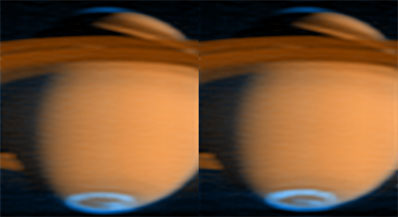
Spaceflight Now +

|

|

|

|

Premium video content for our Spaceflight Now Plus subscribers.

First tile gap filler
 This extended movie shows Steve Robinson riding the station's robot arm, moving within reach of Discovery's underside and successfully pulling out the first protruding tile gap filler. (6min 45sec file) This extended movie shows Steve Robinson riding the station's robot arm, moving within reach of Discovery's underside and successfully pulling out the first protruding tile gap filler. (6min 45sec file)
 Play video Play video

Second tile gap filler
 This extended movie shows Steve Robinson successfully pulling out the second protruding tile gap filler. (9min 23sec file) This extended movie shows Steve Robinson successfully pulling out the second protruding tile gap filler. (9min 23sec file)
 Play video Play video

Storage platform
 The External Stowage Platform-2 designed to hold spares and replacement equipment for the space station is attached to the Quest airlock module's outer hull during the spacewalk. (6min 29sec file) The External Stowage Platform-2 designed to hold spares and replacement equipment for the space station is attached to the Quest airlock module's outer hull during the spacewalk. (6min 29sec file)
 Play video Play video

Station experiments
 Japanese astronaut Soichi Noguchi climbed 60 feet above Discovery's payload bay to the space station's P6 solar array truss to attach the Materials International Space Station Experiment-5 package. (4min 08sec file) Japanese astronaut Soichi Noguchi climbed 60 feet above Discovery's payload bay to the space station's P6 solar array truss to attach the Materials International Space Station Experiment-5 package. (4min 08sec file)
 Play video Play video

Opening the suitcase
 Noguchi deploys the MISSE-5 package, revealing a host of material samples to the space environment for extended exposure. (3min 43sec file) Noguchi deploys the MISSE-5 package, revealing a host of material samples to the space environment for extended exposure. (3min 43sec file)
 Play video Play video

Atop the station
 Noguchi's helmet-mounted camera provides a stunning view atop the P6 truss showing Discovery to his right and the Russian segment of the space station on his left. (2min 31sec file) Noguchi's helmet-mounted camera provides a stunning view atop the P6 truss showing Discovery to his right and the Russian segment of the space station on his left. (2min 31sec file)
 Play video Play video

Inside Mission Control
 This behind the scenes footage was recorded inside Houston's space station flight control room during the third Discovery spacewalk. (8min 45sec file) This behind the scenes footage was recorded inside Houston's space station flight control room during the third Discovery spacewalk. (8min 45sec file)
 Play video Play video

Next mission to Mars
 NASA's next voyage to the Red Planet is introduced by project managers and scientists in this news conference from 1 p.m. EDT on Thursday, July 21. The Mars Reconnaissance Orbiter will launch in August on a mission to provide the sharpest images ever taken of Earth's neighboring planet. (34min 10sec file) NASA's next voyage to the Red Planet is introduced by project managers and scientists in this news conference from 1 p.m. EDT on Thursday, July 21. The Mars Reconnaissance Orbiter will launch in August on a mission to provide the sharpest images ever taken of Earth's neighboring planet. (34min 10sec file)

 Play video: Play video:
Dial-up| Broadband

 Download audio: Download audio:
For iPod

 Become a subscriber Become a subscriber
 More video More video

|

|

|

|
|

|

New Cassini images show 'Northern Lights' of Saturn
UNIVERSITY OF COLORADO NEWS RELEASE
Posted: August 4, 2005

New ultraviolet images from Cassini spacecraft show auroral emissions at Saturn's poles.
Download larger image version here
|
New images of Saturn obtained by a University of Colorado at Boulder-led team on June 21 using an instrument on the Cassini spacecraft show auroral emissions at its poles similar to Earth's Northern Lights.
Taken with the Ultraviolet Imaging Spectrograph aboard the
Cassini orbiter, the two UV images, invisible to the human eye, are
the first from the Cassini-Huygens mission to capture the entire
"oval" of the auroral emissions at Saturn's south pole. They also
show similar emissions at Saturn's north pole, according to
CU-Boulder Professor Larry Esposito, principal investigator of the
UVIS instrument built at CU-Boulder's Laboratory for Atmospheric and
Space Physics, and Professor Wayne Pryor of Central Arizona College,
a UVIS team member and former CU graduate student.
In the false-color images, blue represents aurora emissions
from hydrogen gas excited by electron bombardment, while red-orange
represents reflected sunlight. The images show that the aurora
lights at the polar regions respond rapidly to changes in the solar
wind, said the researchers. Previous images have been taken closer
to the equator, making it difficult to see the polar regions.
Major changes in the emissions inside the Saturn south-pole
aurora are evident by comparing the two images, which were taken
about one hour apart, they said. The brightest spot in the left
aurora fades, and a bright spot appears in the middle of the aurora
in the second image.
Made by slowly scanning the UVIS instrument across the
planet, the images also contain more than 2,000 wavelengths of
spectral information within each picture element. Researchers will
use the wavelength information to study Saturn's auroras, gases, and
hazes and their changing distributions.
The UVIS observation team includes researchers from
CU-Boulder, NASA's Jet Propulsion Laboratory, Central Arizona College
and the University of Southern California.
The Cassini-Huygens mission is a cooperative project of NASA,
the European Space Agency and the Italian Space Agency. The Jet
Propulsion Laboratory, a division of the California Institute of
Technology in Pasadena, manages the Cassini- Huygens mission for
NASA's Space Science Mission Directorate in Washington, D.C.
|

|

|

|
|



